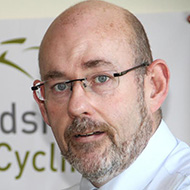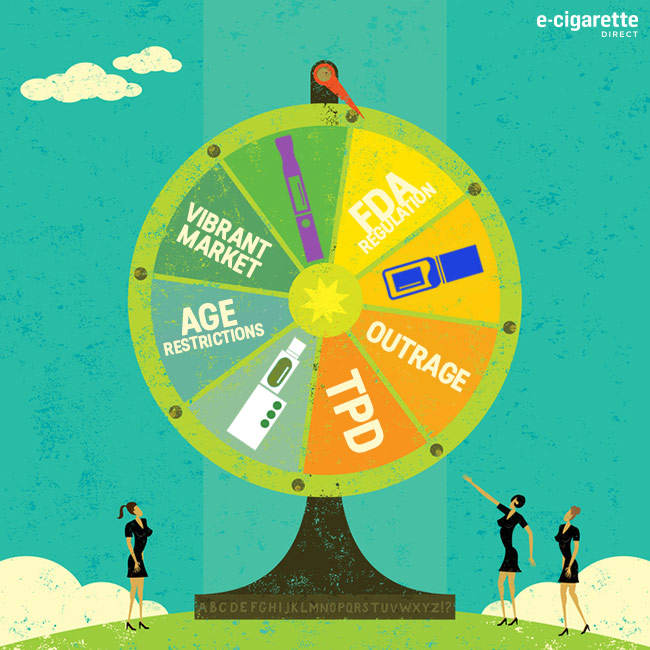The Future of Vaping: 15 E-Cig Experts Share Their Predictions For 2017 December 16 2016
12.16.2016 | By: www.ecigarettedirect.co.uk
For the fifth year running, some of the biggest voices in the e-cig industry have gone out on a limb to predict the future of e-cigs next year.
This year we’re delighted to bring you thoughts from scientists, public health, a documentary maker, vape activists, trade organisations, consumer organisations, bloggers and more.
Click on the expert below to read their prediction.
Clive Bates Former director of Action and Smoking in Health

Trump will offer a silver lining for American vapers; the U.S. market will come back from the brink of an apocalypse.
Alex Clark Legislative Coordinator, CASAA Consumer Advocates for Smoke-Free Alternatives Association

FDA regulations are living on borrowed time… 2017 is the year that we start fighting back.
Konstantinos Farsalinos Vaping’s most prolific researcher

We will see interesting developments in regard to bad quality #ecig studies! #ecigpredictions
Louise Ross Manager for Leicester’s Stop Smoking Service

The evidence will show that as the use of #ecigs rises, smoking prevalence falls
Pamela Gorman Executive Director of the Smoke-Free Alternatives Trade Association

“After the elections… we are very cautiously optimistic”
Prof JF Etter Over 18 years of conducting smoking etiology, prevention and cessation research, including some of the first e-cig studies to be conducted

“In 2017, we will see the expansion of new products developed by the tobacco industry”
Tim Phillips E-Cig Intelligence digs deep into the trends and regulatory industry

“the sector is not going away, but there will be more and more change and fights to come”
Richard Hyslop Chief Executive Independent British Vape Trade Association

“Despite the challenges [for #vapers], there are many reasons to remain optimistic”
Professor McManus Jim works to improve the health of over 1,1 million people in Hertfordshire

“The fact all most vapers want is a cleaner, safer form of nicotine than tobacco risks being forgotten”
Sarah Jakes A founding trustee of the consumer led charity New Nicotine Alliance

“The EU will include #vape products in the Tobacco Excise Directive, but the minimum rate will be zero”
Jim McDonald Jim is the editor of the Vaping 360 blog

“For the first time since the US [e-cig] industry began, there is a potentially sympathetic legislative environment”
Aaron Biebart Aaron is the director of the docufilm, A Billion Lives

“#abillionlives: 2017 will be the turning point in this war”
Oliver Kershaw Inventor, blogger, activist

In the UK, the (#ecig) market looks set to remain as vibrant as ever.
Tim Mechling Tim Mechling is Mt Baker Vapor’s writer and content creator

“Americans will see fewer #vaping options in 2017”
Paul Barnes

Going into 2017, many vapers and indeed vendors are still blissfully unaware of what is about to befall the industry.

Clive Bates, Ex-Director Action on Smoking and Health: A Silver Lining in the US
WHO will have a new DG in 2017, and by the end of the year, I hope there is a change in attitude – but this may take a while to percolate through. If the successful candidate is David Nabarro, then I believe a major change is possible. In the meantime, WHO will continue to press for e-cig prohibitions in developing countries. But this will be matched by countries like Canada, Australia and New Zealand finally ignoring their out-of-time tobacco control zealots and liberalising to allow for harm reduction strategies.
In the UK and EU the TPD will continue to annoy and frustrate, but will not stop the rise of vaping as producers and consumers will find workarounds. Its absurd restrictions, pointless burdens and unintended consequences will become ever more apparent and hasten the case for a replacement.
“Team Trump will offer a silver lining for American vapers and the U.S. market will come back from the brink of an apocalypse”
The European Commission will hesitate to include vaping in a new proposal for a revised Tobacco Excise Directive, following a massive response to its consultation and persuasive advocacy, but some member states will still try it on with new vaping taxes.
Heat-not-burn will be overtaxed, over-regulated and undervalued, but only because they are tobacco products, not because they aren’t 90+% safer than smoking. With heat-not-burn, tobacco control activists who have had to swallow hard and face the highly beneficial emergence of vaping will get back to their prohibitionist industry-bashing comfort zone and thousands of smokers will be harmed as a result. So I predict more acrimony in public health, even in England.
There’s a legal challenge to the snus ban in play. If it gets to a full court hearing, I predict it will win. But given procedural hurdles, I only give it 50% chance of a day in court.
Brexit won’t make any difference for vapers, other than reducing potentially beneficial UK influence in Europe.
Alex Clark, CASAA: The Fight Back

Alex writes here on behalf of CASAA. The largest consumer organisation in the world, for years CASAA and it’s tens of thousands of members have fought tirelessly against campaigns to legislate and tax e-cigarettes out of existence.
Website
Many are cautiously optimistic about the change in the political landscape in Washington, D.C. 2017 will likely present an opportunity to effect change in the scope of federal regulations that currently threaten to shut down the vapor market. However, going forward, it is important to make the distinction between a slam-dunk policy change versus an opportunity.
At the federal level, the 2017-2018 legislative session will bring a push for more sensible regulation of vapor products. This will include legislative efforts to carve vapor products out of the current FDA regulations. We will also see an effort to soften the impact of the regulations not only for vapor products, but also for other low-risk alternatives to smoking. Given a new hope for the industry, we will also see a stronger effort to develop meaningful legislation and regulations that protect consumers while at the same time allows for innovation.
The immediate need to modernize the 2007 predicate date remains a priority and this will be the focus in the first part of the year. Although it is possible to see this predicate date change included in the omnibus budget bill in the spring, it is also possible that this effort drags on into 2018. Developing and implementing useful regulation that compliments a tobacco harm reduction strategy will likely take years rather than months, but 2017 will be the year we start to see progress.
States will be ramping up efforts to bring the industry under their thumbs. This will be especially true if FDA regulations are rolled back. The most prominent policy battles will likely be over taxation, place bans, where flavored vapor products can be sold, and raising the minimum legal purchase age to 21 (Tobacco 21). States may also seek to impose standards on the industry, and there will be some battles over what state actions are preempted by federal legislation.
“FDA regulations are living on borrowed time…and 2017 is the year that we start fighting back.”
In states where inappropriate policies have been enacted, 2017 will be the year that we start to see some rollback. While taxes on vapor products are not likely to be lowered or repealed, other regulations like place bans and overbearing standards will be amended.
Counties and Municipalities will see neo-prohibitionists continuing to advance their anti-nicotine agenda. As we approach a post-drug war environment, lawmakers turning up their noses at harm reduction strategies seems more and more absurd. A key component of this discussion will be how health professionals communicate health and lifestyle information to young people. All lawmakers will be openly challenged to investigate the honesty of policies and campaigns that inform youth about the potential harms of risky behaviors.
Local policy battles will include Tobacco 21, place bans, and where flavored vapor products can be sold. Focusing on these battles will require new resources from state and national organizations.
It’s not just about vapor and it never has been.
2017 is the year that we stop talking about vaping in isolation from the rest of tobacco harm reduction products. Heat not burn (HnB) products have already been introduced abroad with resounding success and likely will be arriving in the United States within the next two years. And, of course, smokeless tobacco has been around for centuries. Both of these types of products will be at the center of the tobacco harm reduction discussion.
Vaping has certainly caught the imagination of consumers, entrepreneurs, and regulators, but any conversation about nicotine removed from smoke is incomplete without considering ALL smoke-free products.
Konstantinos Farsalinos
But after the presidential elections, there is room for hope. The US is the biggest market of e-cigarettes, but quite different compared to the European. I hope the Europeans will be able to communicate their perspective and experience to the US, and hopefully things will improve. COP-7 is a repetition of a disaster.
In few words, the WHO position is characterized by evidence denialism and abuse of the precautionary principle. I feel sorry for the smokers of countries which have followed the WHO recommendations to ban e-cigarettes. They are missing a huge opportunity to reduce their health risk.
“Bad quality studies accompanied by impressive press statements are becoming increasingly frequent … I think we will see some interesting developments in this aspect soon.”
Research is growing, but bad quality studies accompanied by impressive press statements are becoming increasingly frequent. This creates the need to be alert and replicate several of these studies in order to clarify misinformation and misconceptions. I think we will see some interesting developments in this aspect soon.
Finally, we should not forget the introduction of novel harm reduction products to the market, mainly heat-not-burn tobacco products. I expect that in 2017 there will be a lot of discussion about these products.
Louise Ross: An End to Negative Stories on E-Cigs?
More people will realise this is the trend, and not fear that vaping is a gateway into smoking; the evidence will show that as the use of e-cigs rises, smoking prevalence falls.
The evidence will show that as the use of #ecigs rises, smoking prevalence falls
Surveillance will demonstrate, by the end of 2017, that in states and countries where regulation all but stamped out vaping, smoking rates rose again for the first time in years. Policy-makers and regulators will hang their heads in shame.
Pamela Gorman, Executive Director, SFATA

Pamela Gorman is the Executive Director of the Smoke-Free Alternatives Trade Association (SFATA). Prior to working in the private sector, she was a state legislator, serving both in the Arizona House and Senate. Always a fierce defender of free markets and individual rights, her work today is focused on protecting the vapor products industry and preserving adult access to this revolutionary technology.
Website
Rising regulatory demands on companies will shift resources away from R&D and into regulatory compliance. To meet that need, a new complimentary industry of contract compliance officers serving small to medium sized companies will pop up.
These new companies will be the big winners in this year’s vapor economy. Smart companies with a desire to operate after 2018 will also begin pouring some of those funds into their trade associations and advocacy efforts to try and get the law fixed before having to put millions into PMTA required studies.
“after the elections and the actions already taken by the Trump transition team, we are very cautiously optimistic”
You will see a renewed sense of urgency compelling elected officials to roll back FDA regulations. At the state level, many will be surprised to learn that FDA regulations did NOT cause state and local governments to leave us alone. The recent U.S. Surgeon General’s report is a good indicator of what our opposition will be lobbying for in the states. Watch for increased age restrictions to 21, taxes, flavor restrictions, and licensing requirements that act as a de facto ban on vapor shops in some areas.
As long as SFATA has the financial resources to do so, we will continue to take the fight to government bodies on behalf of our member companies. Honestly, after the elections and the actions already taken by the Trump transition team, we are very cautiously optimistic. Hopefully, at the end of 2017, I’ll be writing about the rebirth of innovation in this amazing, life-changing industry!
Professor Jean Francois Etter, University of Geneva: New Products from Big Tobacco

Jean-Francois has over 18 years of conducting smoking etiology, prevention and cessation research, including some of the first e-cig studies to be conducted.
In the US and the EU, it is not impossible that the tobacco industry will take most of the market from new vaporization technologies, to the detriment of the e-cigarette as we know it today, and to the detriment of manufacturers and merchants who are independent from the tobacco industry.
“In 2017, we will see the expansion of new products developed by the tobacco industry”
I hope that 2017 will see a change in WHO’s attitude towards new vaporizing technologies and towards the risk reduction approach, WHO should take leadership, base its position on science, be more courageous, and it should not align with the position of those among its Member States who are most opposed to new technologies. I also hope that in Europe, a large and effective movement will emerge and will be influential enough to eventually change the TPD.
Tim Phillips: The Sector Is Not Going Away, But There Will Be More Challenges…

E-Cig Intelligence digs deep into the trends and regulatory changes in the e-cig industry. Few should be able to predict changes in trends more accurately than MD, Tim Phillips.
Website
Having just read the US Surgeon General’s report, together with the WHO’s COP7 report a few weeks ago, the year seems to be ending on a rather negative note for the sector. But looking forward to next year, what is clear is that demand for alternatives to combustible cigarettes is not going away.
Heated tobacco has launched in many markets with PMI’s IQOS more successful than many expected, and other products set to launch shortly. New regulation which will bite next year will enable less-marginal businesses to sweep up a lot of extra customers. Whether consolidation will occur simply by a lot of businesses dropping out of the market, or more formally by takeovers/mergers, or a combination remains to be seen, but many companies will do well from a more ordered and consolidated market. The new Trump presidency and the situation in Congress will likely as not have a positive impact in the US in terms of changes made to the eventual implementation of the Deeming regulations.
“the sector is not going away, but there will be more and more change and fights to come”
In Europe, the TPD will require much more agility and intelligence from companies in the sector (advertising is a perfect example – there’s plenty of scope to advertise successfully under the TPD in most countries, but the unimaginative won’t get it). So again I think there may be something of a clear-out but it will less overwhelmingly favour the “big”.
In short, the sector is not going away, but there will be more and more change and fights to come, with emerging winners and losers being established next year. What is clear is that this is never a dull industry to be working in!

Richard Hyslop, IBVTA: Cause for Optimism

Richard Hyslop, Chief Executive Independent British Vape Trade Association. Richard has worked within the vape industry for the last four years and has a background working in politics, business, and trade associations.
Website
The TRPR is now in force and as law-abiding businesses, IBVTA members will comply with it, whether or not they agree with it. If “doing the right thing” is not to become a disincentive, as well as a competitive disadvantage, it is vital that these new regulations are policed and enforced.
2017 is likely to be another challenging year as the TRPR comes into full effect on the 20th May and the debate around taxation continues. It will also be the year when guidance will be produced on how companies can and cannot market their products and businesses under the TRPR.
Whilst the TRPR may be the law of the land, it is not an acceptable way for the products IBVTA members manufacture, import, distribute, or sell to be regulated in the long-term.
“Despite the challenges [for #vapers], there are many reasons to remain optimistic.”
With this in mind, in 2017, IBVTA will continue to make the case for a regulatory regime that protects consumers, whilst at the same time is vape specific and proportionate to the limited risk posed by vape products.
Despite the challenges, there are many reasons to remain optimistic.
Currently there are at least 2.8 million vapers in the UK. All of these vapers are now smoking significantly fewer or no tobacco cigarettes as a direct result. This should be a cause for celebration.
There is a thriving independent vape industry in the UK providing these consumers with a wide range of quality vape products. According to one recent study, vaping is now the fastest growing industry in the UK and after the United States the UK is the second largest market for vape products in the world. At a local level, vape shops are one of the few areas of growth on our high streets according to research published by PwC.
The UK’s independent vape industry has a global reputation for quality and innovation. Combine this with the enlightened approach many in the public health field have taken towards vaping and the positive attitudes within Public Health England, the MHRA, and the Department of Health, then the UK really does have the potential to become a global leader in vaping; both in terms of shaping the global policy environment, and also in terms of generating exports and boosting the UK economy.
This tremendous opportunity will only be realised if the regulatory and fiscal environment in which our industry operates is proportionate. Under such a regime vaping would flourish and achieve its full potential in providing a viable and significantly less harmful alternative to tobacco products as well as providing a significant and much needed boost to the UK economy.
Jim McManus, Public Health Director: A Year of Change & Division

Jim works to improve the health of over 1,1 million people in Hertfordshire. His writings and talks combine deep insight with compassion and humour.
Blog
The more agile smoking cessation services will counteract this by marshalling a wide choice of tools to help folk quit including cleaner nicotine (whether as ENDS or NRT) and behavioural support.
They will weather public sector funding cuts better. Those who don’t will continue to be vulnerable.
Unhappy polarisation in views will continue. Over-reaction will see one extreme continue down the fruitless road of berating public health departments for having no value while the other takes up a counter-productive anti-nicotine puritanism. Both will distract attention from the potential shared goal of ending death and disease from tobacco.
“The fact all most vapers want is a cleaner, safer form of nicotine than tobacco risks being forgotten”
Under the guise of being champions of vaping as liberal choice, a few loud voices will exploit opportunities to push a retrograde pro-tobacco agenda, painting public health functions as lacking relevance and credibility. The shrill and brittle tactics of some extreme anti-vaping public health “spokespeople” will be seized on to further undermine public health efforts. The fact smoking still kills risks being forgotten by all sides.
The needed debate about what harm reduction means can lead like a kindly light in this dark storm. Is nicotine or tobacco the enemy? If tobacco, then we need to articulate the harm reduction agenda so we can all coalesce around it.
The advent of heat not burn products may ignite these combustible divisions once more. There will be no smoke, but plenty of ire.
Sarah Jakes

A founding trustee of the consumer led charity New Nicotine Alliance Sarah Jakes is a tireless vape advocate who engages with public health organisations, policy makers and regulators in order to improve understanding of tobacco harm reduction products and strategies.
Website
In response to these changes many vapers will turn to importing from China and domestic businesses will suffer from the increased competition. Among these imports there will be an increasing amount of poor quality cloned products and we will see an increase in consumer dissatisfaction and accidents.
Across the EU we will see a confusing patchwork of regulation and many smaller UK businesses will be unable to cut through the red tape involved in continuing to sell there. Vaping in many parts of the EU will decrease as member states gold plate the TPD with use bans, flavour bans and excise duties.
The EU Commission will succeed in including vaping products in the Tobacco Excise Directive, but the minimum rate will be zero. In the UK the Government will adopt the zero rate, but other countries will not be so lucky. The Governments of those countries will find out the hard way that this new revenue stream will be much smaller than anticipated, and will be far outweighed by the cost of reducing the incentive for smokers to switch.
“The EU Commission will succeed in including vaping products in the Tobacco Excise Directive, but the minimum rate will be zero”
In the US, as some vape businesses take to the courts just to survive, others will throw in the towel. Whilst Trump may represent a change to the Obama administration which oversaw the regulations that will be the end of the industry, his apparent admiration for President Duterte of the Philippines murderous war on drugs leaves me less than optimistic.
2017 will see a range of novel reduced risk tobacco products launched by the tobacco industry as they try to compete with the vapour market. Most of these will struggle to find a foothold in the UK market in the short term. As availability of these products increases so too will the acrimony between those who support a harm reduction approach and those who are ideologically opposed. If you thought 2016 was brutal, wait to see what 2017 brings.
Jim McDonald, Vaping 360

Jim is the editor of the Vaping 360 blog, which offers superb industry analysis and product reviews for vapers.
Website
With Republican control of the executive branch and both houses of Congress, there is a real possibility not just for a band-aid approach like the Cole-Bishop amendment, but for a long-term solution — maybe even a rewrite of the Family Smoking Prevention and Tobacco Control Act, separating non-combustible e-cigs from the tobacco products the act was actually intended to control.
There may also be a possibility that the FDA’s deeming rule could be reversed using the Congressional Review Act, the 1996 law that gives Congress the ability to overrule executive agency regulations with a joint resolution of both houses of Congress. It’s not yet clear though if the deeming rule will qualify for this action.
“For the first time since the US [e-cig] industry began, there is a potentially sympathetic legislative environment”
For the first time since the American industry began, there is a potentially sympathetic legislative environment.
Trump will likely be eager to overturn any kind of anti-business regulation put in place by the Obama administration, and to replace the agency heads that implemented what he sees as rampant regulatory overreach. And it can’t hurt that vaping’s two biggest friends in Congress — Wisconsin Sen. Ron Johnson and California Rep. Duncan Hunter — were both supporters of the incoming president when he was considered a long shot.
The pieces are in place for positive change. Will the year of the big push lead to a permanent fix that saves the critically endangered independent vapor industry and guarantees a brighter future? Stay tuned.

Aaron Biebert, A Billion Lives: 2017 will be the turning point in this war.
Countries that own large tobacco companies will continue to resist the science. France will join the UK as a global evidence-based policy leader. Hungary, Estonia, and other small European countries will see improvements as the science becomes undeniable.
If advocacy organizations in the US unite, they stand a real chance of reversing the most harmful parts of the FDA deeming regulations. Surprisingly, big tobacco companies will assist (and then begin their domination of the injured market).
In the near term, the industry in the US will continue to suffer as state and national anti-vaping efforts see success.
Production of a follow-up movie to A Billion Lives will be announced in 2017, continuing the #ABillionLives movement, giving advocacy efforts more ammunition, and putting stronger pressure on the big companies and NGOs that are promoting unscientific bias amongst the global medical community.
Oliver Kershaw: A Year of Divergent Paths

Inventor, blogger, activist – Oliver has many strings to his bow! He is best known for founding e-cigarette forum, which has helped millions of smokers to switch to vaping.
Forum
The opaque nature of the US regulations (what does it take to register a PMTA?) means that liquid companies will bow out as each milestone of the regulation comes into play. The first is a manufacturing registration requirement at the end of this year. The second comes into play in February, and is much more problematic because it requires ingredient disclosures that many will not be able to comply with. What, then, will happen to these liquids?
In my opinion, the FDA will move forcefully against those that do not pass the “smell test”. FDA doesn’t have the resources to go after everyone, so will go after unregistered brands selling fruit/candy/bakery type flavors, especially those who use descriptors which appear childish (using a subjective test). So far the FDA has taken a soft approach, issuing warning letters to underage sellers, and this will likely be the opening salvo against liquid companies too. That said, they will be mindful of their public health remit and are unlikely to want to cause mass disruption which causes people to go back to smoking. My belief is that they’ll go after some high-profile targets such that others simply decide to exit.
Remember, this regulation is “prohibulation” – the FDA simply cannot perform a top-down regulation – it doesn’t have the resources – it needs to thin the market down to a number which it can regulate.
So we’ll see lots of businesses taking the rational decision to exit the market at such a point as when things become too much to bear. When will this be? Well, some have already decided to do so – one of ECF’s long-standing favorites bowed out this month. In my private conversations with others, it’s become clear to me that this is going to be the dominant choice, absent of Cole-Bishop or a regulatory volte-face.
For those with the appetite for the long-haul, it’s really going to be a question of plausibility. It remains a complete unknown as to whether it’s even possible for an e-liquid or open device to be granted a PMTA. The FDA itself doesn’t seem to believe so.
“In the UK, the [#ecig] market looks set to remain as vibrant as ever.”
But, then again, the FDA itself remains the wildcard, especially following the election. I’ve seen some people stating that Zeller’s resignation would be helpful – but this is doubtful. Zeller has had to play a political game, but he does support overall harm reduction objectives. Would his replacement be similarly inclined and capable? Whoever takes his place is going to be sitting on a bureaucracy with a 20-year history of fighting to regulate nicotine, and that’s not going anywhere. IMO, Zeller’s actually the only person who could change things around, if the wider political weather changed.
Another thing that’s not going anywhere: vapers! Vapers want to vape, and they don’t want products which don’t work. The saddest thing for me is that it might all fail to reach its full potential and be the disrupter we know it can be. I feel like this is all just beginning, and the next 12 months could be the point at which it all flattens into something horrifyingly underwhelming, despite the number of lives it’s transformed on the way.
Oliver adds: “and just to prove that prediction is a mug’s game, the FDA announced last week that it’s extending the deadline for manufacturer registrations for 6 months. How this all plays out long term is anyone’s guess”
Tim Mechling, Mt Baker Vaper: Americans will see fewer vaping options in 2017

Tim Mechling is Mt Baker Vapor’s writer and content creator who has been active in the vaping community since 2013. His unblinking eye gazes unto the abyss of oppression.
Blog
Americans will see fewer vaping options in 2017. Some bigger names in the vaping industry have already fallen on hard times. Flavors, DIY supplies, and much of the customizability vapers have come to love will be restricted in the coming year.
The prohibitive cost of PMTAs will coerce vape companies to strip down to their bones; a few blockbuster flavors will be available in select nicotine levels, and anything off-beat will be eliminated.
Scoff-laws will be crucified. Vape shop owners will pace the floors, pondering how to keep their doors open.
Distrust for government and its agencies is at a fever pitch, which may bring hope to the vaping community. Brexit and the election of Donald Trump are symptoms of social unrest, and a bulging, red middle-finger has been thrust at the establishment. How the frenzy of furious populism plays out remains to be seen, but the anti-regulation conservatives and libertarians that fill the House of Representatives, Senate, and the White House are apt to challenge Federal regulations. An optimistic vaper would foresee the Trump Administration taking a sledgehammer to the Deeming Regulations. A cynic would distrust any starry-eyed promise from a politician, no matter the packaging. I personally lean to the latter.
The amount of wealth held and shuffled by Big Pharma, Big Tobacco, and Big Government is nearly unfathomable. Vaping has risen to challenge the status quo, and has marginally upset the momentum of cigarette revenue, and its peripheral markets. There is no doubt these behemoth agencies will further flex their muscle.
“2017 will be a trial-by-fire for bigger vape companies, and a death knell for mom-and-pop vape shops.”
The idealist in me sees an uprising of vapers, and a David-versus-Goliath triumph. The realist in me sees the vape industry slithering, ragged and lugubrious, unto oblivion.
Paul Barnes: A Great Deal Of Uncertainty

Paul works in IT and spends his off-hours writing about vaping science and other freedom of choice matters. Usually with tongue in cheek humour, and occasional expletives. Not for the easily offended. 18+ rating.
Website
So where does that leave us for 2017? Cloudy, with a chance of meatballs.
Frankly it leaves vapers worldwide with a great deal of uncertainty going into 2017. With the WHO FCTC having not really altered their prohibitionist stance despite the report from the RCP, the evidence update (and workplace guidance) from PHE, the very recent RCGP statement and the reply to the WHO from UKCTAS. We know for certain that specific signatory countries will enforce harsh measures as a result of COP7 – they were always going to regardless of the outcome, although the UK will undoubtedly remain possibly the most liberal – or at least, as far as the regulations allow. How long will that last is a question I’m sure many advocates have in the back of their minds.
“Going into 2017, many vapers and indeed vendors are still blissfully unaware of what is about to befall the industry”
As with going into 2017, many vapers and indeed vendors are still blissfully unaware of what is about to befall the industry. New e-juice ranges keep popping up and there has been a gamut of new hardware in an effort to get product to market ahead of regulatory cut-offs (TPD notification, FDA Deeming). A fact that some pro-vaping public health individuals have realised, hopefully there’ll be a more concerted effort to bring realisation to the industry.
Of course, overall perception isn’t being helped by the media over-sensationalising research. For every research paper that is published highlighting the benefits of vaping, there is at least two or three that say the exact opposite. The balance of research through 2017 will undoubtedly remain more of the same – and with the regulations biting deeper, the main protagonists in research (via the media) will only get worse.
The domino effect of prohibition (either in full or in part) will accelerate. We’ll see more US states levy taxes, the EU will no doubt follow – though to what extent remains to be seen. Instead of outright prohibition, or a medicalised route, we’ll see the continuation of ling-ch’ih – the death of the industry by a thousand cuts – and the further creation of an organised black market. Innovation will stall, with manufacturers hands being tied by the various regulatory barriers that have been, and continue to be erected by the various Governmental bodies. With that, demand will decrease – the boom of the last few years ahead of the regulatory imposition will turn into a rapid downturn – which in turn will cause smoking prevalence rates to stagnate.
Conclusion
Last year we noted that while the TPD meant restrictions on what could be sold, enforcement is going to be difficult.
And that’s already proving to be the case, with many shops selling products which have not being notified.
If this continues, expect outrage from businesses which have spent many months and huge resources first fighting and then getting ready for the TPD. However, we are likely to see some enforcement starting from May 2017.
Over in the US, meanwhile, we are waiting to see if the new US administration will take a different stance towards e-cigs. They have promised to cut regulation and protect US businesses – will this be carried out in reality? We can only hope!
In summary – things could be much worse in Europe and the UK. They are much worse in the US, but there is hope. And the WHO is really messing things up in the rest of the world…


